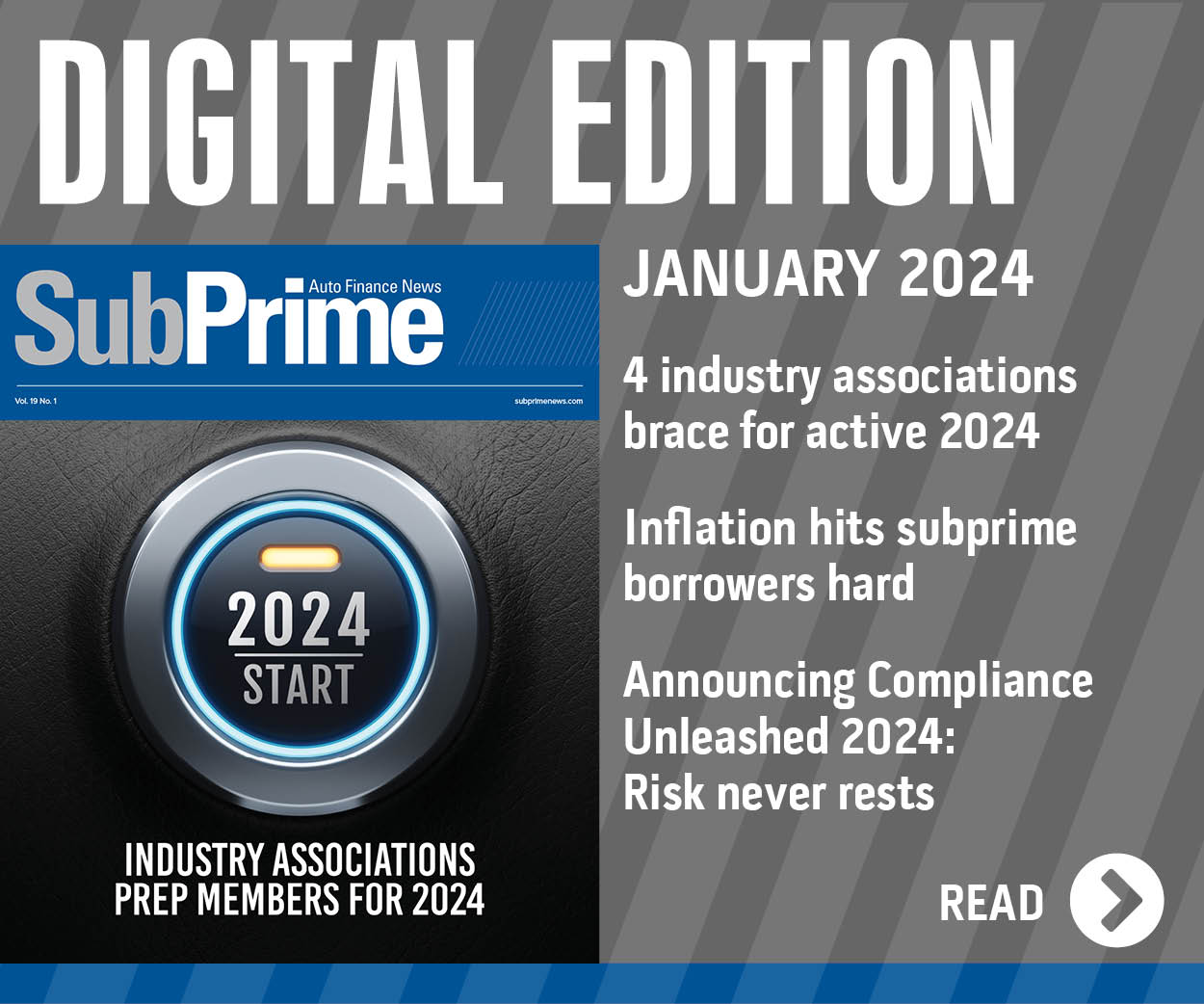AmeriCredit: 4Q Loan Originations Up, Charge-Offs Down
FORT WORTH, Texas (Aug. 9, 2006) — Thanks to solid loan originations and fewer charge-offs, AmeriCredit executives said business in the fourth quarter of the 2006 calendar year continued to prove strong. Quite simply, executives credited a favorable economic environment in the quarter for AmeriCredit's ongoing growth.
"Two key drivers of our earnings — loan originations and credit results — were strong in the quarter," explained Dan Berce, president and chief executive officer. "Loan volume for the fourth quarter was at the highest level since 2002 and charge-offs were at the lowest level in over four years. Our overall performance was a result of sound execution and a favorable economic environment."
More specifically, AmeriCredit announced net income of $79 million for the fourth quarter, compared to net income of $77 million a year ago. Executives noted that net income included a $6 million after-tax loss ($9 million pre-tax) related to the redemption of senior notes. As for the fiscal year, net income came in at $306 million, as opposed to $286 million for the last calendar year.
Loan Originations Climb
For the fourth quarter, AmeriCredit said its loan originations grew to $1.73 billion, compared to $1.45 billion in the same time frame of the last year. Loan purchases for the year came in at $6.21 billion versus $5.03 billion for fiscal 2005.
As for managed auto receivables, they totaled $12.20 billion as of June 30. AmeriCredit's portfolio covers $806 million of prime and specialty prime loans originated through Bay View Acceptance.
"Loan purchases in the June quarter included $78 million of loans originated through the Bay View platform since the acquisition was completed on May 1," said Berce. "The loans originated in the June quarter represented a higher quality mix of credit as compared to last quarter primarily because of the Bay View originations.
"We conducted business with more than 13,500 auto dealers, about 500 more than the March quarter and about 1,500 more than this same time last year," he continued.
Discussing the growth the company has shown, Berce went on to say that, "The number of independent dealers we do business with continues to grow, contributing 6 percent to our loan volume in the June quarter. Canadian loan originations are getting off the ground, as we add marketing and credit staff and expand our geographic reach. We are also now making direct-to-consumer loans through several newly created channels."
Looking ahead, Berce said the company plans to continue increasing loan originations by approximately 15 to 25 percent.
Credit Results Follow Seasonal Trends
As witnessed in previous years, AmeriCredit reported its credit results followed normal seasonal patterns as net credit losses improved, while early and late-stage delinquencies increased when compared to the last quarter.
Thirty- to 60-day delinquencies came in at 5.1 percent, compared to 4.7 percent in the prior quarter and 5.2 percent posted a year ago, executives said. More specifically, without Bay View, 31- to 60-day delinquencies were 5.5 percent for the quarter. Moreover, accounts greater than 60 days past due were 2.1 percent, compared to 1.6 percent in the third quarter, but down from 2.2 percent a year ago. Excluding Bay View, accounts greater than 60 days past due were 2.2 percent for the time frame, executives said.
Accounts receiving a deferment were 6.2 percent of the portfolio for the period, up from 5.6 percent from the last quarter. Excluding Bay View, accounts receiving deferments were 6.5 percent for the time frame.
"Net credit losses in the managed portfolio decreased during the June quarter to 3.9 percent from 5.2 percent in the March quarter and 4.2 percent a year ago," Berce stated. "Net credit losses were 4.1 percent of the managed portfolio, excluding Bay View loans. In addition to the Bay View portfolio, net credit losses continue to benefit from a favorable economy and strong recovery rates."
Continuing on, executives said recovery rates on vehicles sold at auction were up a bit, hitting 49.9 percent for the quarter, as compared to 49.8 percent in the third quarter and 48.3 percent a year ago.
"The relative strength in our recovery rates is partially attributed to our favorable mix of vehicles at auction," Berce noted. "As compared to the Manheim Used Vehicle Value Index, our mix of vehicles sold at auction has a higher percentage of compact cars, which are among the leading segments in price gains over the last 12 to 18 months.
"At the same time, recovery values on SUVs show a decreasing trend in relation to the total index," he added. "Our mix of vehicles is less heavily weighted with SUVs than the Manheim index. As we have stated in prior quarters, we anticipate that used car values will moderate slightly, and as in the past, be seasonally weaker toward the end of the calendar year."
Finance Income Grows
Chris Choate, AmeriCredit's chief financial officer, announced the company's finance charge income reached $459 million for the quarter, or 16.4 percent of average on-book receivables, as compared to $414 million, or 16.6 percent in the previous quarter.
"Finance charge income increased during the quarter because our average on-book receivables increased by $1.1 billion from the March quarter," Choate explained.
He went on to point out that the average APR charged through Bay View was lower, as those financed through this venue had higher credit ratings. Due to this fact, there was an impact on finance earnings for the company, he said.
"The portfolio yield decreased slightly from March to June of 2006 due to the inclusion of the Bay View portfolio, which carries lower APRs than the AmeriCredit loan portfolio," he said.
Moving on, Choate also discussed the company's provision for loan losses. He said AmeriCredit recorded $157 million in provision for loan losses for the quarter, compared to $119 million last quarter and $115 million a year ago. The company's provision for loan losses was 5.6 percent of the average on-book portfolio for the quarter versus 4.8 percent for the third quarter and 5.5 percent last year.
"The increase in our provision for loan losses was the result of several factors," Choate said. "First, in the March quarter, we increased the recovery rate assumptions used to forecast probable net credit losses, causing a decrease in the provision for loan losses for that quarter. We did not make a comparable adjustment to our recovery rate assumptions for the June quarter. This is illustrated by the fact that the provision for the March quarter, as a percentage of average on-book receivables, was only 4.8 percent, compared to normal levels of 5 to 6 percent.
"Second, the absolute volume of originations in the quarter affects our provision for loan losses," he continued. "And since loan originations were higher in June, the provision for loan losses increased.
"Finally, the timing of loan origination volume throughout the year influences the provision for loan losses with respect to when loans enter their peak loss period," he added. "Therefore, credit mix and economic considerations aside, the provision for loan losses will generally experience upward pressure after periods of high origination levels, and conversely, downward pressure after periods of low origination levels."
In the future, Choate said the provision for loan losses will continue in the range of 5 to 6 percent, depending on credit performance and more factors.
Looking Ahead
AmeriCredit executives said they anticipate continued growth down the road, albeit with some challenges to overcome.
"We believe AmeriCredit will continue to grow loan originations above market rate," Berce stated. "Our industry leading expertise for serving franchised dealers by offering subprime auto lending solutions for their customers provides strong growth potential. Our market-expansion initiatives targeting independent dealers, the Canadian market and direct-to-consumer lending are gaining traction."
Furthermore, Berce said, "The economic environment is still favorable. The job market in the U.S. is steady, which should help sustain current credit trends in the near term. On the other hand, we are closely monitoring developments that may affect consumer credit performance, such as high energy costs and a weakening housing market. We are committed to proactively managing the growth through adjusting our credit mix if economic conditions turn adverse."

 View The Latest Edition
View The Latest Edition

